|
by Dr Floor Anthoni www.seafriends.org.nz/indepth/octopus.htm |
 |
 |
|
by Dr Floor Anthoni www.seafriends.org.nz/indepth/octopus.htm |
 |
 |
|
|
|
| An old heritage
It is thought that the inkfishes (cephalopods) originated from early gastropods (slugs and snails) some 500 million years ago in the Ordovician epoch of the Palaeozoic (see our Geologic time table). Their ancestor looked a bit like a large limpet, but with its internal organs in a different arrangement. Its head developed tentacles and its foot formed the funnel (jet pipe). Its mantle developed into a bag in which the gills are located and also its anus and sexual organs. Its external shell first developed into a cone, still worn by belemnites that became extinct with the dinosaurs. |
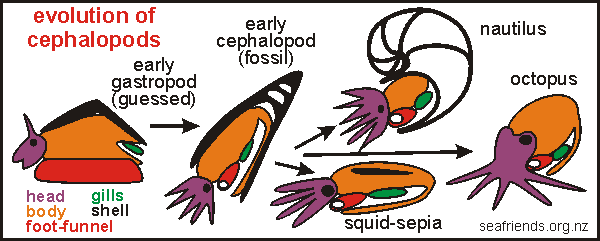 |
| Today's cephalopods are as varied as all other molluscs combined, even though they are not represented by as many species (marine molluscs 90,000; cephalopods 900). All cephalopods occur in the sea only and all are predators. The drawing below shows how varied they are. |
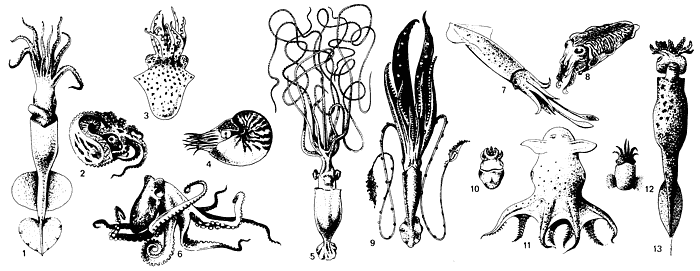
Main types of inkfish: 1.Grimalditeuthis richardi 2.Argonauta argo 3.Tremoctopus hyalinus 4.Nautilus pompilus 5.Chiroteuthis portieri 6.Octopus vulgaris 7.Loligo pealeii 8.Sepia officinalis 9.Chiroteuthis lacertosa 10.Tremoctopus hirondellei 11.Vampyroteuthis infernalis 12.Sepiola 13.Taonius pavo |
| Cephalopods are such weird creatures that their classification has been in constant revision, and is likely to be revised yet again. One would have thought that squid can be distinguished from octopus because they have ten arms instead of eight. However, the way inkfish have been grouped today, squid are those inkfish with hard hooks or saw-like cups around their suckers, whereas octopuses have soft stalked suckers. (See molluscs/classification/cephalopoda) |
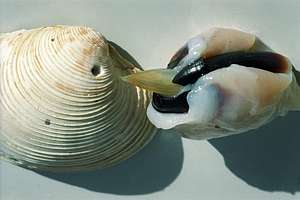 |
 |
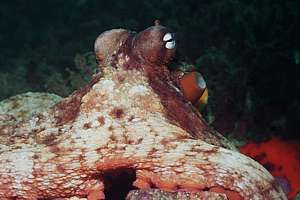 |
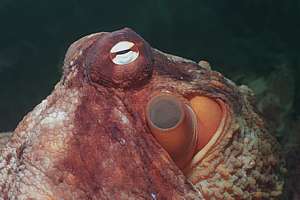 |
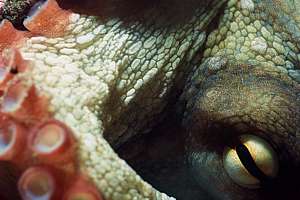 |
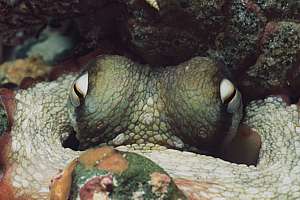 |
| In our aquariums we had a special tank for an octopus - a prison really. A new octopus would hide in the farthest corners, but once it lost its fears, it would always hang around right in front, watching the goings-on in the other tanks. In other words, with its mind it lived in the whole tank room, being quite aware of other objects and even prey moving in far away tanks. |
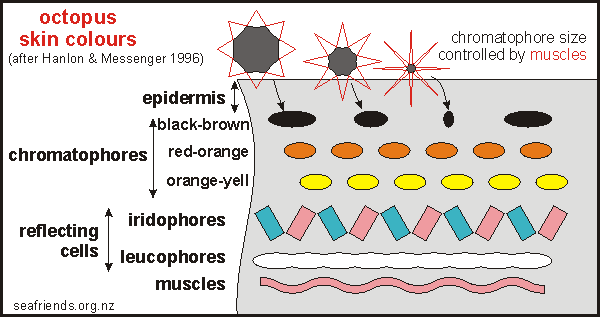 |
Of all cephalopods, the sepia (the Mediterranean sepia is Sepia officinalis)
is the most amazing skin painter. Alas it does not occur in New Zealand.
A sepia can change its colours so rapidly that it can mimic the rolling
patterns of waves. When mating, it sports gaudy zebra patterns. A young
sepia can literally disappear before one's eyes, no matter where.
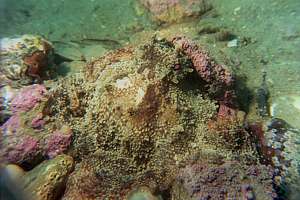 |
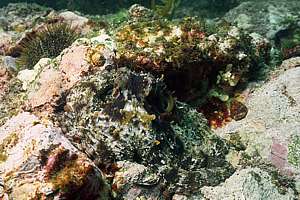 |
 |
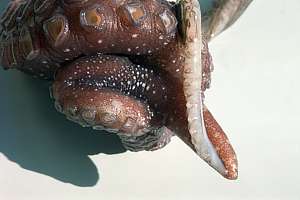 |
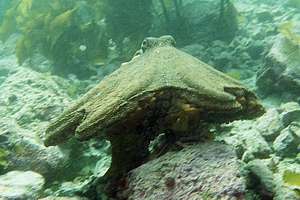 |
| How to lose an arm
While we were filming octopus and how they move, we caught a large octopus by enticing it out from underneath the rock where it lives. At the time we were also surrounded by inquisitive fish, snapper and blue cod. As soon as we held the octopus, a blue cod attacked and within two seconds bit off an arm. It did this by biting it high up where the arm begins, and then spinning around at a rate of about 4 times per second. To remove such an arm with a diver's knife would certainly have taken a lot longer. While scurrying away, the blue cod was persecuted by snapper and a fight ensued for the severed arm, resulting in everyone getting a bit. Then another blue cod attacked. We now had an octopus with only six arms and not much would be left had we not returned it to its safe lair under the stone. |
| The ninth hand
The jet pipe of an octopus is more than just for swimming and breathing. It uses it for all kinds of purposes. It is an excellent digging tool for removing sand and it can puff at animals that come too close for comfort. Female octopuses use it to spout their eggs towards their finest suckers by their mouths, and later to aerate the eggs and to keep them clean from sediment. But it can also be used to feel around, while not exposing its arms. It works like this: Imagine yourself in your garden with a garden water hose. Adjust it to a firm spout while standing in front of an object like a tree. Now close your eyes while moving the spout around. Every time it hits the tree, you feel the nozzle in your hands recoil because the water's recoil at the tree is passed up through the water spout. With your eyes closed, you are now able to get a fair idea of the objects around. This is how an octopus uses its water spout to feel around. It also uses the spout to flush out crabs from their hideouts. |
| Killing the lights
Our octopus tank is very well secured, but in its ceiling of overlapping glass panes, tiny gaps of no more than 1cm squared can be found. One octopus found this by squirting its water spout around and finding no resistance. With the spout it could now explore what was hanging above its tanks - a fluorescent light. At one end of this light it found a very unusual sensation, an electric shock! Now one would think that this electrocution would have put him off for good, but this was not so. Instead it was fascinated by it, trying again and again, and getting shocked many times. In the end the light shorted out and its terminal pins gave way. The octopus had destroyed the whole armament, and it needed to be replaced. Of course the 1 cm gap was taped over afterwards. Now get a mental picture of this, as all the while the octopus hung down from the ceiling panes above the water, its body dipping sufficiently low into the water for it to be able to breathe and spout. |
| Liquefying the sand
The sand octopus is found in good numbers inside a sheltered harbour where also good numbers of shellfish are found, and where the tide does not go out. One such place is Whangamumu Harbour, just south of Cape Brett and the Bay of Islands. It is a favourite shelter for yachts and runabouts staying the night. Because of its shelter, the sand there is fine, not a problem for clams, the biggest ones burrowing deepest. For an octopus to catch a meal, it has to dig down to the level of the clam, and even deeper as the clam tries to escape. In the meantime the fine sand keeps caving in, rendering the exercise futile. I've tried to do this myself, but the crater I create becomes wider and wider rather than deeper. Then I happened upon a small crater of no more than 20cm across (the size of a hand). It had caved in by about 2cm (a finger's width), showing a perfectly horizontal plane of fine sand, rather than a cone. I touched the sand inside the crater, and it was completely liquid, allowing me to reach all the way down to the bottom, some 25cm down (to my wrists). What was going on here? Why had the crater not collapsed? I then realised that octopuses have a trick up their sleeves, being able to liquefy fine sand by pumping some of their ink (a protein mix) into it. Once the sand is liquefied, the octopus just needs to reach down and pull its victim up. That day I found several liquefied craters. |
| Coveting shiny objects
Octopuses appear to like shiny objects. Underwater photographer Kim Westerskov recalls an encounter with a large octopus that had no fear at all. It walked right up to him and grabbed his underwater camera, subjecting it to a thorough inspection. What's more, it wanted to take off with it. So a fight followed, and the octopus backed off. However, the camera's lens had been bent and could not be used again. I had a similar experience at Great Barrier Island when a large octopus made a beeline for my movie camera. It pulled at the camera and could have done damage to it, but recalling Kim Westerskov's experience, I went along with it. Instead I used my movie lights to distract it, and the animal let go. But it stayed around, watching my every move as I was filming. While diving at Island Bay in Wellington, my camera suddenly was jerked sideways, as an octopus was intent on keeping it. After I managed to pry the animal from the rock, I also managed to hand my second camera to my son, who then filmed the affair. It ended all happily, giving both the octopus and us an unforgettable experience! |
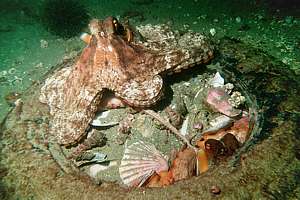 |
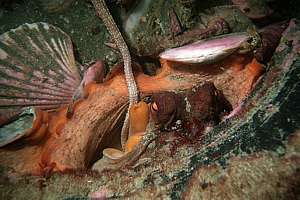 |
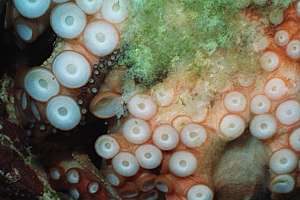
f002706: a female sand octopus lays her eggs through her jet pipe which she funnels really small onto her mouth. Each egg has a sticky thread. With the finest suckers around her mouth and using her finest tentacles, she gathers the eggs into strings and attaches these to the wall. |
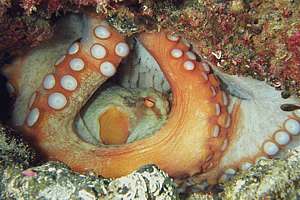 |
| house with a view
Octopuses are quite ingenious in the ways they seek out a suitable spot, and in the ways they adapt such a spot by dragging stones towards it. |
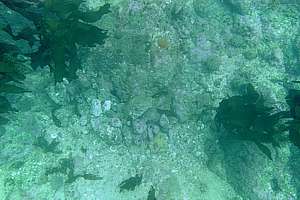 |
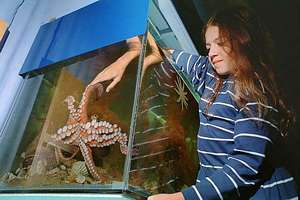 |
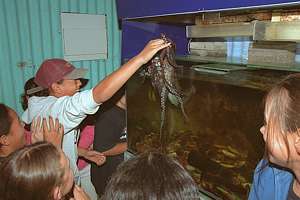 |
| Shaking hands with children
In the Seafriends' marine aquariums we have a tank dedicated to a single octopus. It is almost hermetically sealed, for octopuses are escape artists and can squeeze themselves through very small holes. We catch a baby octopus by placing a peanut butter jar under water, hidden in between some rocks. Soon enough a small octopus will make this its home. Catching it then becomes simply placing one's hand over the jar and quickly screwing the lid back on. In the aquarium the octopus soon finds its way out of the opened jar, but then our 'training' begins. Every day we spend half an hour 'playing' with the octopus, which in the very beginning consists of merely putting one's arm in the tank, and then day by day closing in on it. Finally it will reach out to our hand, and eventually the pulling and pushing becomes play. By about three weeks, an octopus is 'tamed' and has no fear. It can then also be fed by hand. When schools visit Seafriends for an unforgettable day out, the tank is opened to allow children to interact. Soon the octopus hangs over the glass, extending its arms to say hello, while children scream from excitement, and from their suppressed fears. Only the very daring allow their hands to be held by the octopus. Because octopuses grow so fast, we have to return them to the sea before winter, and catch a new one in spring. Unfortunately, after many years, the octopus had to make room for the creation of a complete ecosystem where the aquarium's sea water is no longer replaced but only recirculated. In such a system, an octopus becomes an unbearable burden, as it is rather voracious while growing fast. Perhaps later when our ecosystem has proved itself, can we have another tame octopus. |
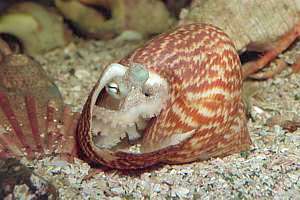 |
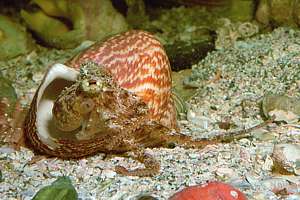 |
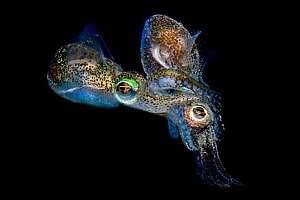 Photo courtesy Cal Mero, Australia. f038535: a diver finds two spent paper nautilus shells. These are very fragile and disintegrate within a few months. |
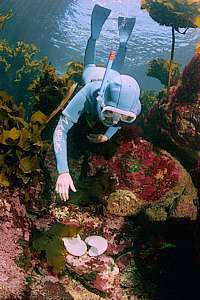 |
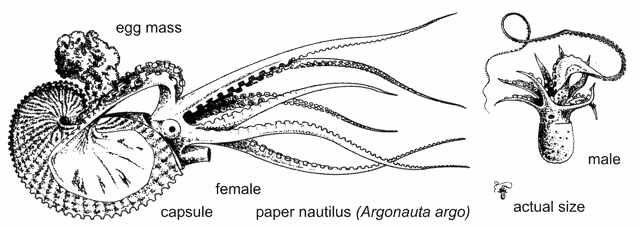 |
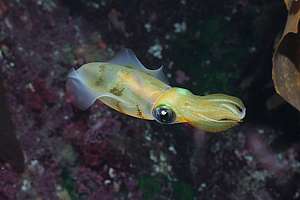 |
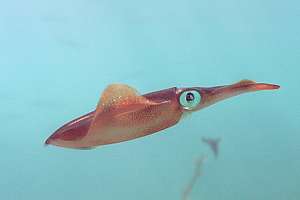 |
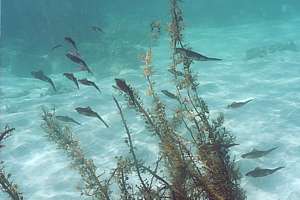 |
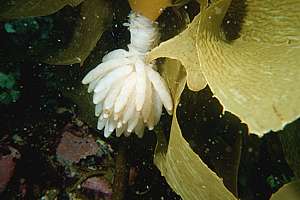 |
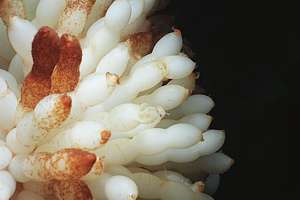 |
 |
| Night dive with squid
While swimming back from a night dive in Leigh harbour, I happened on a school of large broad squid that were attracted by the permanent lights on the wharf. Having seen how fast a broad squid can demolish its prey with its parrot beak, I was rather intrepidated, being surrounded by fifty of these devouring beasts. But they were just interested in the movie lights. The most courageous one shot forward, grasping the light and holding on to it. That gave me a chance to stroke its almost luminescent green-white belly, something it appeared to enjoy as it was flashing wave patterns over its back, which immediately drew the other squid nearby. Then they had turns clasping the light while being stroked, and their skin patterns became weirder and flashier! They were crowding around me, keen not to miss a moment. Then the battery ran out. |
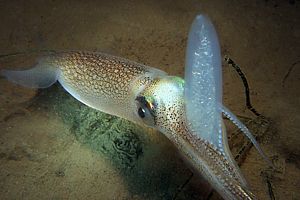 Photo courtesy Scott Gietler. |
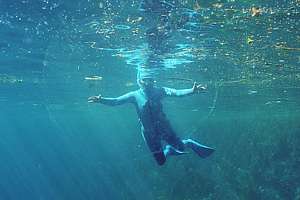 |
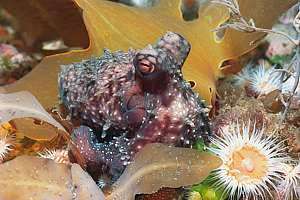 |
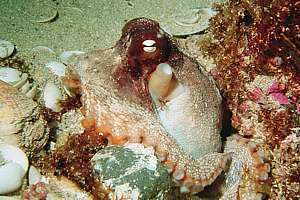 |
| House with a view
Because octopuses have such excellent eyesight, they like to live inside a house with a view, rather than in an alley. Particularly the sand octopus has this preference. Being also a predator, eventually exhausting its food supply, it also needs to move frequently. It is not uncommon for an octopus to have various work huts in addition to the mansion with a view, where it returns. One can often find an octopus just sitting on a perch, enjoying the goings-on around it. |
 |
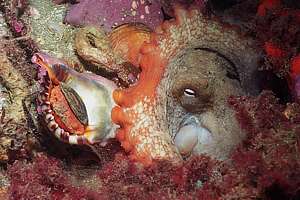 |
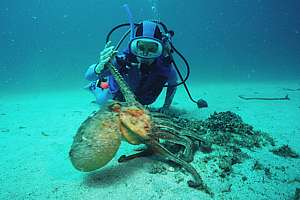 |
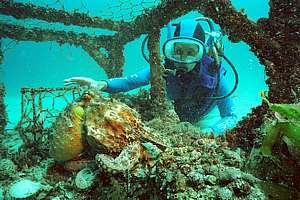 |
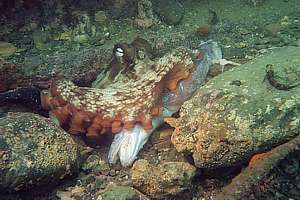 |
| Digging through gravel
Leigh Harbour attracts octopuses for an easy meal from bait and fish innards thrown overboard. One day I saw a fine small octopus, just the right size for our aquariums. It sat in the open on a large mound of gravel, heaped up by the propellers of fishing boats. It would be an easy catch as it had nowhere to go, and I could easily outswim a little one like this. So I quickly grabbed it and that would have been the end of it. However, constraining a live octopus, even a small one, is a tall order because it has a slippery skin and is very strong for such a little fellow. To my embarrassment, it escaped and began digging into the heap of gravel. No problem here because a grown man can dig much faster. But then my disadvantage began to show. As the octopus was digging deeper, it placed the spoils behind it, whereas I had to displace the spoils in order to keep the hole from caving in. It didn't take long for the little fellow not only to disappear from sight, but also nowhere to be found! It had literally vanished into the heap of gravel. |
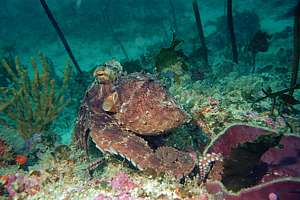 |
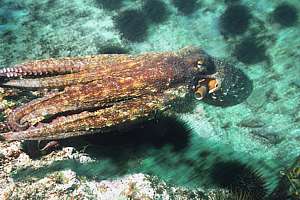 |
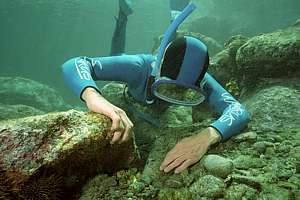 |
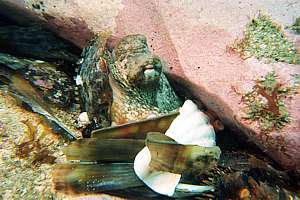 |
External
links
http://en.wikipedia.org/wiki/Cephalopoda
an excellent article about cephalopods with many links for further reading.
http://www.teara.govt.nz/EarthSeaAndSky/SeaLife/OctopusAndSquid/en
interesting and illustrated with photos and video
http://www.thecephalopodpage.org/
information and images of common cephalopods
http://www.fao.org/fishery/sidp/3,3/en
cephalopods of the world, an annotated and illustrated catalogue
of species known to date. UN Food & Agricultural Organisation Species
Identification & Data Programme. Various publications, also in downloadable
PDF.
http://www.tonmo.com/
The Octopus News Magazine Online: news, articles and other octopus information
Books and articles from the Seafriends library
Cousteau 1975: Octopus and squid.
Hanlon, Robert T & John B Messenger (1998): Cephalopod behaviour. Cambridge University Press.
Lane, Frank W 1957: Kingdom of the Octopus.
O'Shea, Steve 1999: Octopoda (Mollusca: Cephalopoda). Biodiv mem 112, NIWA
Powell, AWB 1979: New Zealand mollusca: marine, land and freshwater shells. Collins.
-- Seafriends home -- indepth
index -- site map -- Revised: 20090508,